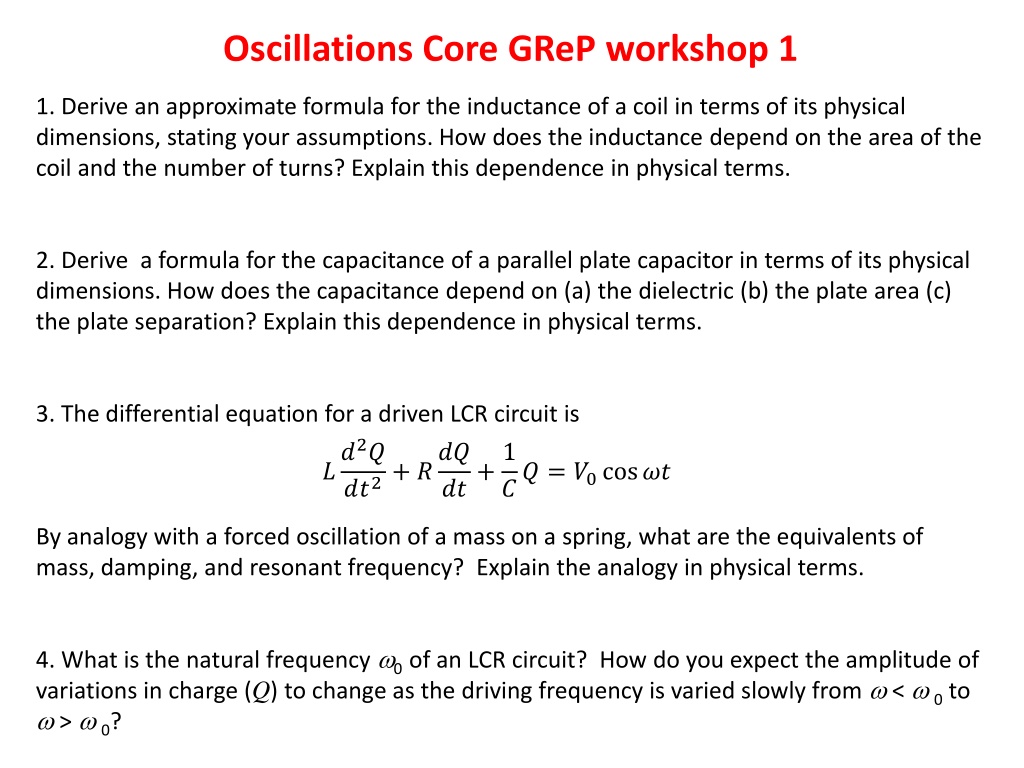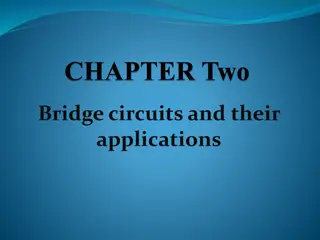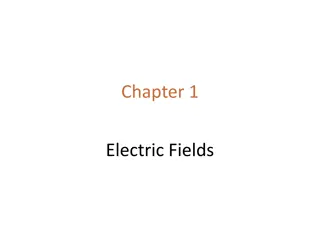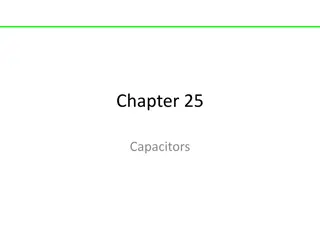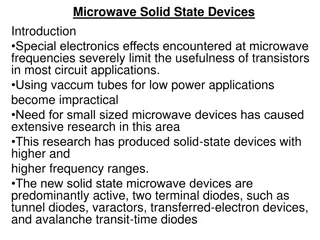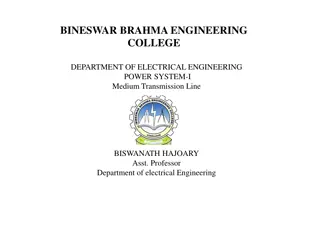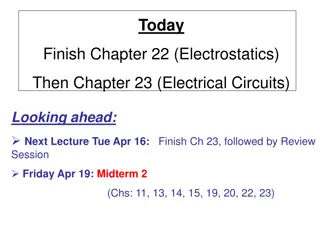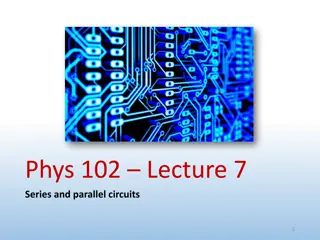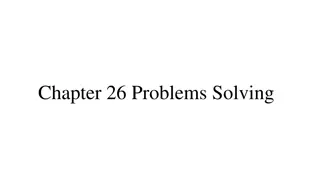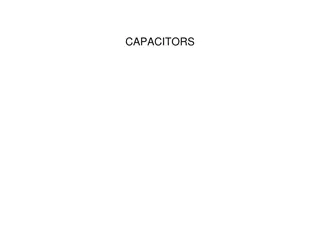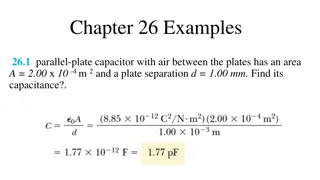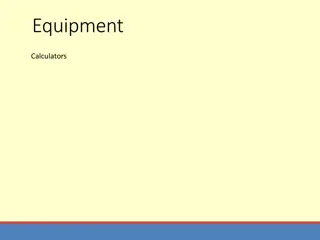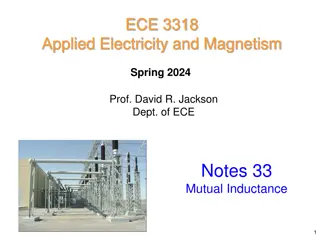Understanding Inductance and Capacitance in Electric Circuits
Explore the derivation of inductance and capacitance formulas in terms of physical dimensions and learn about the dependencies on coil area, number of turns, dielectric, plate area, and plate separation. Understand how inductance relates to magnetic flux and coils while capacitance is linked to charge and electric fields. Analogize driven LCR circuits using concepts of mass, damping, and resonant frequency. Examine the natural frequency of LCR circuits and the variability in charge amplitude with changing driving frequencies.
Download Presentation

Please find below an Image/Link to download the presentation.
The content on the website is provided AS IS for your information and personal use only. It may not be sold, licensed, or shared on other websites without obtaining consent from the author. Download presentation by click this link. If you encounter any issues during the download, it is possible that the publisher has removed the file from their server.
E N D
Presentation Transcript
Oscillations Core GReP workshop 1 1. Derive an approximate formula for the inductance of a coil in terms of its physical dimensions, stating your assumptions. How does the inductance depend on the area of the coil and the number of turns? Explain this dependence in physical terms. 2. Derive a formula for the capacitance of a parallel plate capacitor in terms of its physical dimensions. How does the capacitance depend on (a) the dielectric (b) the plate area (c) the plate separation? Explain this dependence in physical terms. 3. The differential equation for a driven LCR circuit is ??2? ??2+ ??? ??+1 ?? = ?0cos?? By analogy with a forced oscillation of a mass on a spring, what are the equivalents of mass, damping, and resonant frequency? Explain the analogy in physical terms. 4. What is the natural frequency 0 of an LCR circuit? How do you expect the amplitude of variations in charge (Q) to change as the driving frequency is varied slowly from < 0 to > 0?
1. Derive an approximate formula for the inductance of a coil in terms of its physical dimensions, stating your assumptions. How does the inductance depend on the area of the coil and the number of turns? Explain this dependence in physical terms. Inductance defined as the magnetic flux produced by the coil per unit current passing through the coil: = m L I
I A = B BA r m = 2 B r N = 2 NB r m
NI = = 2 0 NB r B m l 2 2 N r I = 0 m l 2 2 N r = = 0 m L I l
2 2 N r = 0 L l Inductance increases with a greater N and r as this increases the flux contained within the coils Inductance decreases with greater l as this reduces the number of turns in unit length, decreasing the flux contained within the coils
2. Derive a formula for the capacitance of a parallel plate capacitor in terms of its physical dimensions. How does the capacitance depend on (a) the dielectric (b) the plate area (c) the plate separation? Explain this dependence in physical terms. d V A
2. Derive a formula for the capacitance of a parallel plate capacitor in terms of its physical dimensions. How does the capacitance depend on (a) the dielectric (b) the plate area (c) the plate separation? Explain this dependence in physical terms. +Q + + + + + + + + E d V A - - - - - - - - -Q Ed V = CV Q = Q C = Ed
a Q = +Q + + + + + + + + E A What is the electric field of a single charged plate? a d = a Ea = E s 2 0 0 S = E 2 0
a Q = - - - - - - - - -Q A E What is the electric field of a single charged plate? a d = a Ea = E s 2 0 0 S = E 2 0
E = 0 +Q + + + + + + + + = 2 E 2 - - - - - - - -Q 0 E = 0 Q = E 0 A
Electric field between charged plates Definition of capacitance Q Q Q = = = C E 0 A V Ed 0 A = C d
0 A A = = 0 C C d d Capacitance increases with a greater A as the charge on the plates is spread out, and more charge can be accumulated before leading to a high electric field between the plates Capacitance decreases with greater d as this leads to a greater potential difference between the plates, and the more difficult it is to accumulate charge on them Capacitance increases with increasing as this reduces the electric field between the plates and hence the potential difference
3. The differential equation for a driven LCR circuit is ??2? ??2+ ??? ??+1 ?? = ?0cos?? By analogy with a forced oscillation of a mass on a spring, what are the equivalents of mass, damping, and resonant frequency? Explain the analogy in physical terms. Deriving this expression: Apply Kirchhoff s loop rule: dI Q + + = cos L IR V t 0 dt C dQ I = Substitute for I: dt
2 d Q 2 dQ Q + + = cos L R V t 0 dt C dt Mechanical analogy, mass on a spring: 2 d x 2 dx + + = cos m b kx F t 0 dt dt LCR circuit Q 1/C L R Mass on spring x k m b charge flows back and forth, mass moves back and forth capacitor wants to discharge, spring pushes mass inductor resists change in current flow, mass has inertia energy dissipation in resistor, frictional force on mass 1 k 0= natural frequency at which resonance occurs depends on square root of restoring force divided by inertia = 0 LC m
4. What is the natural frequency 0 of an LCR circuit? How do you expect the amplitude of variations in charge (Q) to change as the driving frequency is varied slowly from < 0 to > 0? The resonant frequency is given by 1 0= LC The charge oscillates at the driving frequency . The amplitude of oscillation is a maximum at the resonant frequency = 0, and decreases at lower and higher driving frequencies.
